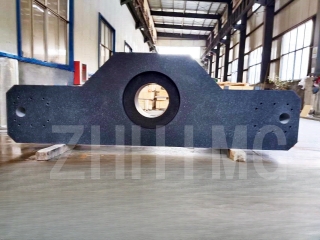Precision granite bed is a crucial component in OLED equipment. It provides a stable and vibration-free platform for OLED deposition processes. The successful structural design of precision granite bed not only enables the equipment to produce high-quality OLED products but also contributes to the efficiency and cost-effectiveness of the manufacturing process. In this article, we will discuss the key factors in the structural design of precision granite bed in OLED equipment.
Material selection
Granite is the most common material used for precision granite bed. The reason why granite is preferred over other materials is that it has excellent mechanical properties, such as high stiffness, high damping capacity, and excellent thermal stability. These properties make granite ideal for applications that require high-precision and stability.
Granite also has a low coefficient of thermal expansion, which means that it can maintain its shape and size even when exposed to high temperatures. This property is crucial in OLED equipment because it helps to minimize the thermal stress that can affect the accuracy of the equipment.
Geometry and Surface Finish
The geometry of the precision granite bed is also important in the structural design of OLED equipment. The bed must be designed in such a way that it can support the loads generated during the OLED deposition process. The shape and size of the bed should be optimized to minimize deflection and vibration.
The surface finish of the precision granite bed is another critical factor. The surface finish must be precise and smooth to ensure that the OLED deposition process is accurate and uniform. Any imperfections or roughness on the surface can cause irregularities in the OLED film, which can affect its performance.
Fixturing and Support
Another important aspect of the structural design of precision granite bed is the fixturing and support system. The bed must be securely mounted to prevent any unwanted movement or vibration during the OLED deposition process. The fixturing and support system must also be designed to accommodate the weight of the equipment and ensure that it is evenly distributed across the bed.
Moreover, the fixturing system must be adjustable to allow for fine-tuning of the equipment's position to ensure that the deposition process is accurate and precise.
Conclusion
The structural design of precision granite bed is critical in OLED equipment as it significantly affects the quality and performance of the OLED products produced. The choice of material, the shape and size of the bed, surface finish, and fixturing and support system are all essential factors that must be considered to design a robust and reliable precision granite bed. By considering these factors, manufacturers can produce high-quality OLED products with minimal defects and achieve high levels of productivity and cost-effectiveness.
Post time: Feb-26-2024

